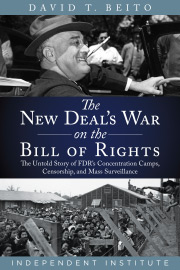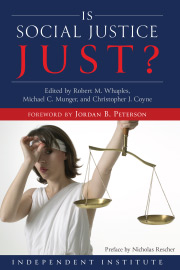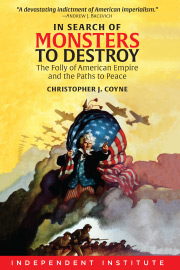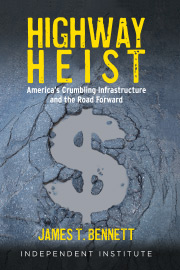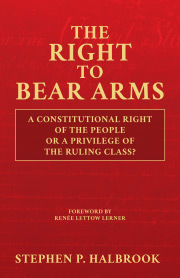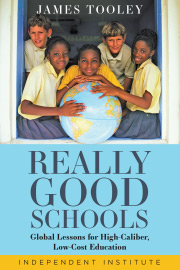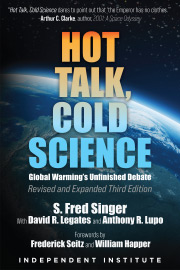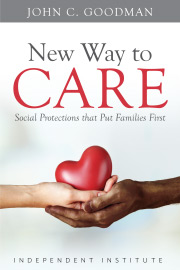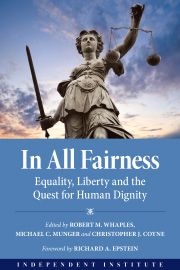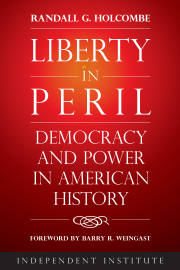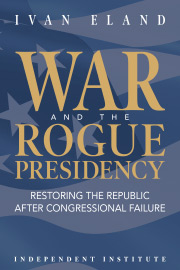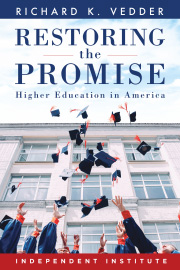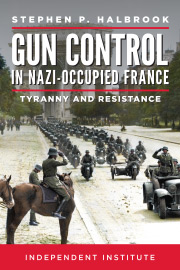Classical Liberalism Is All in Our Heads? Responding to Paul Harvey on Race
In the current issue of Books & Culture, Professor Paul Harvey (not to be confused with the late radio icon) takes aim at my “imagined” (read: invented) tradition of classical liberalism on race. You can read his full review here.
Harvey concedes that Race and Liberty in America rediscovers “understudied authors.” Then he quickly moves on to the usual academic dismissal of any classical liberal “tradition” on race (academics love scare quotes to let the reader know that there really is no such thing).
Since the 1950s, if not earlier, left-liberal academics have argued that classical liberalism ended in the early 20th century. Left-liberals used to argue that there was no conservatism in U.S. history but they have rediscovered a tradition that they find useful to dredge up in contemporary debates. In short, all good things come from the Left.
Yet, Harvey asserts, his students still retain the core values of classical liberalism that I present in my book. Since my book is the first word on “understudied authors” it is subject to the usual criticism that I didn’t discuss everything about the writers, the tensions within their tradition, etc.
Pick up a course reader like Eyes on the Prize and you could make the same objection, except Eyes on the Prize says what academic gatekeepers want to hear (they turned it into a movie series which I use in my classes). I am not criticizing Eyes on the Prize, which is a fine reader laying out the standard academic interpretation of the black civil rights movement from the 1950s onward. Indeed, editor Juan Williams is an open-minded left-liberal who probably disagreed with many figures in my book; nevertheless, he wrote the following blurb:
“If you are interested in the real history of the Civil Rights movement in America—the radical ideas that set it in motion no matter where they came from—get ready for an intellectual thrill ride. There is no time for political posturing here. Race and Liberty in America is full of revelations and stunning in its honesty.”
—Juan Williams, Senior Correspondent, National Public Radio; author, Eyes on the Prize: America’s Civil Rights Years, 1954-1965 and Thurgood Marshall: American Revolutionary
Where did Harvey’s students get their ideas? Why do they believe in individual freedom, limited government and colorblind law? Ideas come from somewhere. Harvey himself admits that many of the authors in my volume are understudied or rarely paired with race (or misunderstood, as with Booker T. Washington). Let me be forthright: there was no classical liberal movement but there were classical liberal values that were coherent and inspired many different individuals (including Harvey’s students?). It’s about an intellectual tradition, not the social movement approach taken by most historians of civil rights. What held these classical liberals together were those values rooted in their understanding of foundational texts (the Bible, the Declaration of Independence, the Constitution).
These values are rooted deep in American culture and shared by individuals who are very different. That is a problem for Harvey. A chief criticism of my book is that the contributors are “so different,” but I make that point on the very first pages!
“Classical liberalism is a philosophy of individualism; its history is peopled by a mix of iconoclasts, contrarians, lone dissenters, courageous rebels, and powerful political leaders.”
Throughout the book, I describe the clashes between classical liberals who burned the Constitution (William Lloyd Garrison) and those who saw it as a “Glorious Liberty Document” (Frederick Douglass). I also emphasize how Christians repeatedly clashed on the issue of race. Contrary to Harvey’s single-minded focus on Barry Goldwater, I discuss how the Civil Rights Act of 1964 divided classical liberals who valued freedom of association but favored the sections that struck down state-sponsored discrimination. While some classical liberals (Goldwater) were ambivalent about certain provisions of the Act, most believe(d) that judicious government action is proper to guarantee “life, liberty, property.”
As for the National Review, my critique of it was so harsh that a blind referee for the publisher ask that I tone it down. Harvey criticizes the National Review “for the legion of classical liberal authors” who used the magazine to attack the civil rights movement. My criticism is that there were no classical liberals allowed to speak on the issue of race. Here is what I wrote in an earlier draft:
Classical liberals and conservatives differed sharply over civil rights. The sharp contrast can be seen on the pages of National Review. Although William F. Buckley established the National Review (1955) as a forum for classical liberal and traditional conservative voices, the former were excluded from discussion of civil rights. The magazine’s conservative writers advocated states rights and “freedom of association,” thus ignoring government-sponsored discrimination in the South. Some of the early editorials and articles were insulting to blacks and sympathetic to Southern whites, even advocating white supremacy (“Why the South Must Prevail” 1957; Hart 2005). Others raised important constitutional questions, but nowhere did National Review offer constructive solutions to racial discrimination. Instead, the magazine read like a law review where authors escaped into abstractions and ignored the cold, hard reality of racism.
By contrast, classical liberals believed state-sponsored discrimination was a problem. Federal laws that struck down such discrimination were not only constitutional but appropriate to achieving individual freedom from state interference (Rothbard 1963, 437). White supremacy, by government fiat, violated classical liberal principles. On the other hand, classical liberals—Murray Rothbard, Ayn Rand, and Barry Goldwater—opposed laws that limited an individual’s freedom of association or that required him (or her) to prefer one race over another. Yet, like conservatives, left-wing liberals had no compunction about using government to discriminate in favor of some and against others (see below).
If the Civil Rights Act of 1964 “worked,” as Harvey argues, then why doesn’t he discuss the many authors I included who want to get us back to 1964?! Nathan Glazer, Shelby Steele, Clarence Thomas, Ward Connerly, Linda Chavez, and Janice Rogers Brown—they argue that Left-liberals abandoned the bright shining moment of 1964. “It’s about race-neutrality, stupid!” (To paraphrase Bill Clinton).
By the way, if one were into slinging mud (not my style), I could note that Goldwater voted for the 1957 and 1960 civil rights bills while JFK voted against the strong Republican bill in ’57 and LBJ watered it down (LBJ also characterized a federal anti-lynching bill as rape of the Constitution!).
As for the other “good” government acts mentioned by Harvey, Race and Liberty in America has a whole section on classical liberals and the postwar Reconstruction Amendments to the Constitution. There is also a section on the drive for a federal anti-lynching bill; classical liberal Moorfield Storey argued that state inaction was a denial of due process and thus violated the 14th amendment.
Even when these classical liberals opposed constitutional amendments or civil rights bills, it was because they believed the Constitution already protected rights given to us by God.
To wit: before the Civil War Frederick Douglass, influenced by Lysander Spooner, opposed amending the Constitution. Why? Because he believed the Constitution already prohibited slavery! In the mid-twentieth century, contributors like Zora Neale Hurston, George Schuyler, Rose Wilder Lane, and R.C. Hoiles believed NOW (the 1940s) was the time for freedom, not a time to wait for Congress to pass bills to “give us” our rights. The 14th amendment guaranteed those rights NOW, they argued. The NAACP (unmentioned by Harvey but praised in my book) repeatedly turned to the 14th amendment and Justice Harlan’s dissent in Plessy v. Ferguson (“Our Constitution is colorblind”). I discuss how NAACP lawyers, many now forgotten (Moorfield Storey, Louis Marshall), won Supreme Court victories from 1917 onward. How? By invoking the 14th amendment. They didn’t wait for civil rights acts. Likewise, there is a libertarian case for legal activism today (see Clint Bolick, David’s Hammer).
Much of Harvey’s review is taken up with ad hominem attacks on individuals who deserve better. Yeah, yeah, R.C. Hoiles opposed Japanese internment but he didn’t believe in public schools and he “defended private discriminatory behavior.” You can imagine Hoiles leading a “private discriminatory” mob. Another word for “private discriminatory behavior” is what most Christians do on Sunday: they “discriminate” between churches. We “discriminate” when we date, accept jobs, etc. Harvey omits the context of the unnamed document: Hoiles was praising a court decision that struck down school segregation. As for public schools, classical liberals led by Milton Friedman have advocated school choice, an issue explored in the book.
Discussing the National Review crowd circa 1964, Harvey writes
“[t]hey drew from the same reasoning as does Pat Buchanan, whose recent diatribe against Sonia Sotomayor and affirmative action and his extolling of the ‘white man who built this country’ simply update arguments extending down from a long line of classical liberal thinkers, including John C. Calhoun, Alexander Stephens, the Southern Dixiecrats, James J. Kilpatrick, William Rusher, and Glenn Beck. In contrast to them, Frederick Douglass’ words lie smoldering in his grave.”
This isn’t reviewing, it is cock-eyed guilt by association.
Harvey does his best to prove me right. In the introduction, I write
“th e standard academic dismissal is to lump classical liberals with unsavory conservatives rather than address classical liberal thought as a distinctive tradition separate from right-wing conservatism and left-wing liberalism (although there is overlap with those traditions).” I quote Angela Dillard to that effect: She cites classic liberals and then writes that “the conservative movement, overall, is predominantly white and Christian and has, in both the past and present, used racism, ethnocentrism, homophobia, and anti-Semitism . . . to achieve its goals.”
Wow! Who would want to be associated with such filth?
Harvey repeats the same old tired cliche:
“Douglass certainly drew (as did most antislavery activists) from the classical liberal tradition, and the contribution of classical liberalism to the antislavery movement stands as its proudest moment. [Note how classical liberalism somehow ended “back then”]. But of course, the most representative defenders of that classical liberal tradition were southerners such as Jefferson Davis and Alexander Stephens, who perceived the Republicans as the party of big government, conspiring to take away local authority, individual freedom (especially property rights), and the proper Constitutional authority of the states.” (Bold added for emphasis)
There is no “of course” about it! As I make painfully clear in my introduction (and throughout), I am examining the classical liberal perspective on race. It simply is not possible to argue that slavery is consistent with classical liberalism. On the GOP, Harvey is half-right but his point is irrelevant. Yes, the Republican Party was the party of Big Government in the 19th century. In the introduction, I write:
“One of the initial objections to this project was that the figures chosen were predominantly Republican from the 1850s onward, and since the Republican Party was the “centralizing” party of the nineteenth century, it was not classical liberal. My response is twofold. First, this project focuses on racial freedom, not on other policies that were possibly antithetical to classical liberalism. Second, the “centralization” argument misses the point: while the Republican Party was more “statist” at the national level with regard to the tariff and other issues (for example, Prohibition), it was less statist with regard to race.”
By the time I got to a mention of Pat Buchanan and Glenn Beck (!), I was expecting Harvey to throw up Ann Coulter or David Duke. After this litany of people who are not in my book (for good reason), one would get the impression that the figures in my book were for everything racially illiberal (segregation, lynching, immigration restriction, forced sterilization of “inferior races”) rather than the ones fighting it, except perhaps up to Frederick Douglass’s day (safely in the past).
This is the first time I have ever responded to a review, partly because the reviewer didn’t bother to relate what the book is about:
What topics does it cover? (Slavery, Chinese Exclusion, lots on immigration, anti-imperialism, the NAACP, Japanese internment, Jewish refugees from Nazi Germany, racial intermarriage, opposition to racial preferences, sports, business and much more).
What is the target audience? Clue: Pat Buchanan won’t like my book judging from my interviews on radio shows with individuals who hold his views.
A response is also required because I expect more of the same. The Right doesn’t like the advocates of open immigration, the Left doesn’t like any one crashing their “civil rights party” (just keep “progressive” Justice Holmes, the eugenicist, in the closet!). That is why I describe the classical liberal tradition of civil rights as “neither left nor right.”
Readers who want to learn more about the book—including other reviews, op-eds and my radio interviews on diverse stations (Right, Left, Christian, black urban radio), may go to here.
